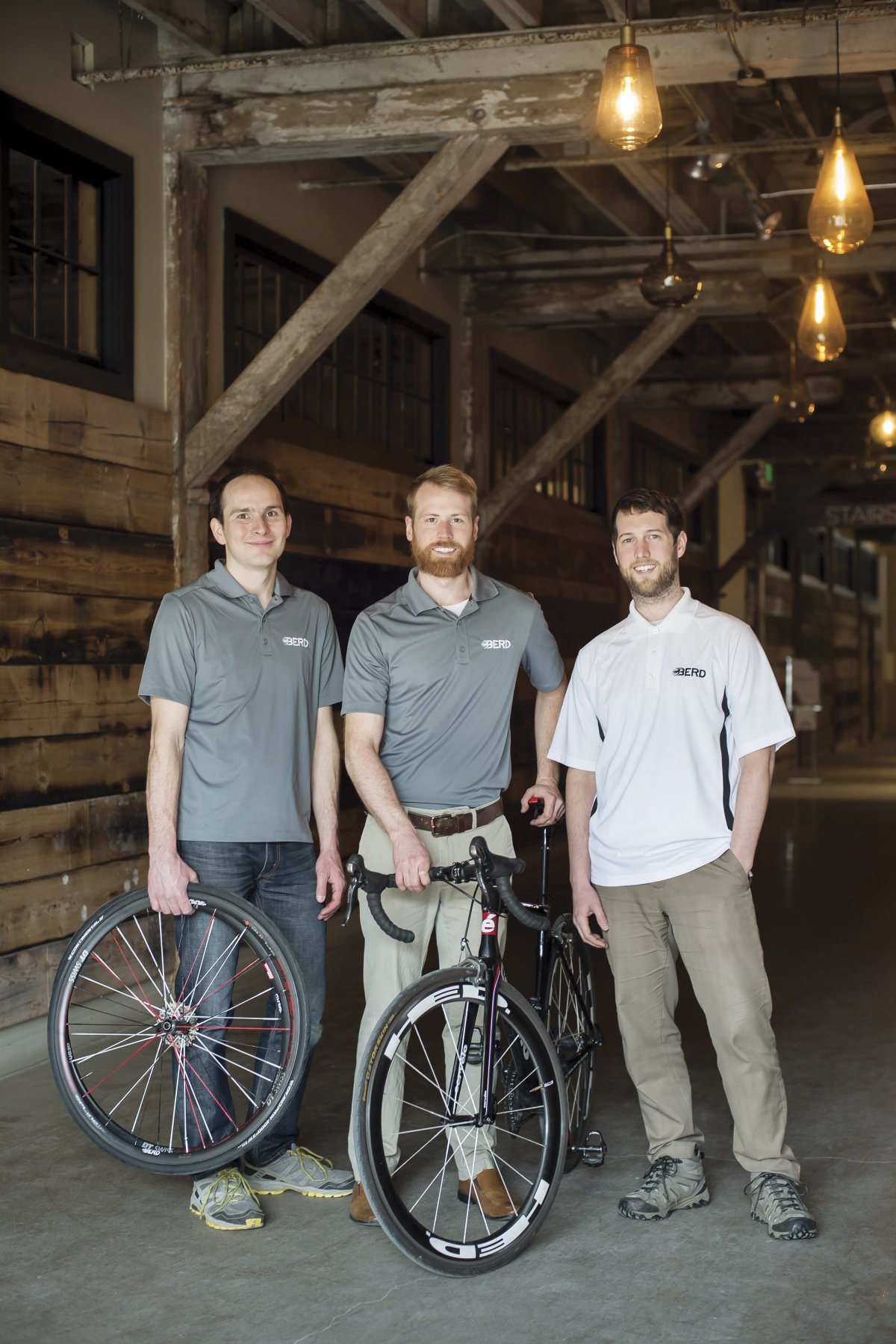Bike nerds

Credit: Caroline Yang
Three cycling enthusiasts use flexible fibers, upending traditional metal wheel spokes
July 9, 2019
A trio of College of Science and Engineering engineers have reinvented the wheel.
“Bike spokes have essentially remained unchanged since the first Tour de France while everything else on the bike has changed over the last 100 years,” said Charlie Spanjers (Chemical Engineering ’10), co-founder of Minneapolis-based Berd LLC, a company that has created new technology for making bicycle spokes from flexible fibers.
“Twenty years ago, the materials just weren’t better than steel. Now we think they are,” Spanjers said.
The race to build a better spoke began with three Minnesota-trained engineers who also happened to be bike nerds.
Spanjers, Kyle Olson (Electrical Engineering ’10 and Ph.D. ’16), and Brad Guertin (Mechanical Engineering ’10 and M.S. ’14) became friends as undergraduates in the University of Minnesota’s College of Science and Engineering.
They tossed around ideas for reducing weight and making improvements. Bike components have become progressively lighter thanks to innovations such as carbon fiber, but one part remained little-changed—the steel spokes. Could flexible polymers replace rigid spokes, they wondered.
The trio brainstormed how to overcome the main barrier—the connections between a polymer spoke and metal rod attached to the wheel rim. They devised a braided polyethylene fiber with a threaded stainless steel rod inserted into the hollow cavity of the fiber. The threads of the rod connect to nipples within the rim.
Spanjers compares the technology to a Chinese finger trap—the more it is pulled, the tighter the connection becomes.
“As far as we know, it has the highest strength-to-weight ratio of any polyethylene-to-metal connection,” he said.
“When you pull, it compresses. That frictional force is what does the majority of the holding,” Spanjers explained.
Like many great ideas, this one arose by accident. Spanjers recalled: “Kyle suggested something, and I said, ‘that’s a great idea!’ I thought he was talking about the Chinese finger trap connection, but Kyle was actually talking about something else. Somehow between the two of us, we came up with something that worked really well.”
The partners founded the company in 2015. Berd touts its PolyLight spoke as “the lightest in the world.”

In 2016, the company won the general division of the Minnesota Cup, a competition for entrepreneurs, which helped attract investors and advisors.
In 2018, it won a $225,000 grant from the U.S. National Science Foundation because it had developed new manufacturing processes for polymer-to-metal connections, an innovation applicable to many domains beyond spokes.
Despite a boom in recent advances in polymeric materials, commercialization has lagged due to the difficulty of connecting these fibers to common materials such as stainless steel.
A smoother rider; a wondrous feat of physics
Indeed, the Berd founders hope to expand into other industries such as sailing, automotive, or aerospace. Their spokes are less than half the weight of metal ones, about 100 to 200 grams lighter for a set of wheels, a difference most noticeable to elite riders. But many cyclists can sense a difference in the smoothness of the ride.
“Metal does a really good job of transmitting vibration,” said Spanjers. “If you pluck a metal spoke, it will ring very nicely. The downside is when you’re biking and hit bumps or rough roads, all those vibrations get transmitted from the wheel to the handlebars and your seat.”
“With our spokes, you get much less transmission of vibration from the road to the rider,” he said. “That’s something immediately noticeable to everybody.”
Berd sells directly to consumers and through stores such as Erik’s Bike Shop. (It costs about $595 to outfit a bike with Berd spokes.) The typical customer is an affluent cycling enthusiast who loves cool new gadgets.
The materials exhibit a wondrous feat of physics that seems counterintuitive.
“When you have something flexible and put it under tension, it can act rigid,” explained Spanjers. “You’re really standing on the bottom spokes.”
Typically, the engineers encounter disbelief from laypeople who assume flexible spokes are impossible.
“There are always all sorts of funny comments—‘this is just vaporware! This product can’t exist!’” said Spanjers. But seeing is believing. “If you bring a wheel,” he said, “it’s a good way to convince them.”
Story by Kermit Pattison
Here are three other College of Science and Engineering alumni pushing the boundaries of their fields:
Heather McDonald: Rocket scientist
